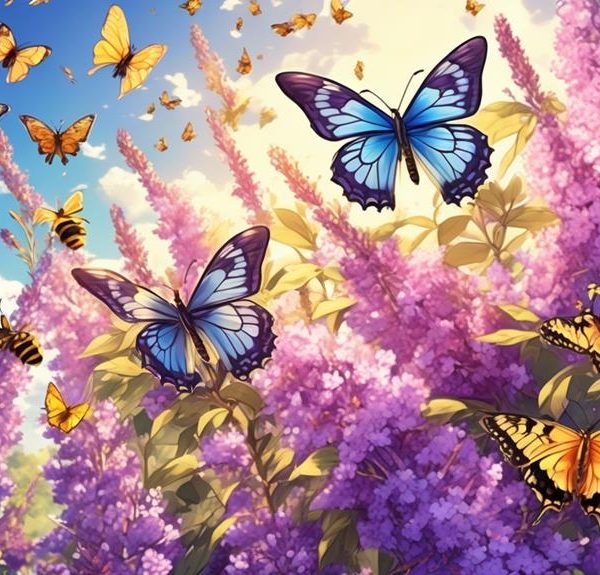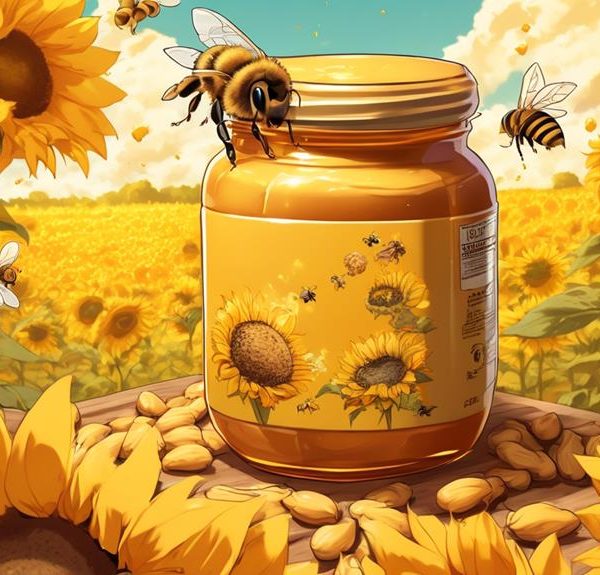Journey with us as we delve into the captivating relationship between bees and the vibrant hibiscus, a floral feast or just a pretty sight?

Do Bees Like Hibiscus?
Imagine yourself as a bee, buzzing through a vibrant garden, your eyes are drawn to the flamboyant burst of color radiating from the hibiscus flower.
As a human observer, you're likely wondering, do bees feel the same magnetic pull to these exotic blooms?
The relationship between bees and flowers is a centuries-old dance of survival, and understanding the nuances of this dance can reveal fascinating insights about both parties involved.
The question you might be asking is – does the hibiscus plant play a significant role in this delicate ballet?
Now, that's a question worth exploring further.
Key Takeaways
- Bees are attracted to hibiscus due to its bright colors and nectar-rich flowers.
- Hibiscus flowers have unique structures that attract pollinators, such as their funnel shape and protruding stamen.
- Bees efficiently collect nectar from hibiscus flowers and transfer pollen, aiding in plant reproduction.
- Understanding bees' affinity for hibiscus can be leveraged in beekeeping strategies to attract more bees, increase nectar collection, and ensure a productive hive.
Understanding Bees' Attraction to Flowers
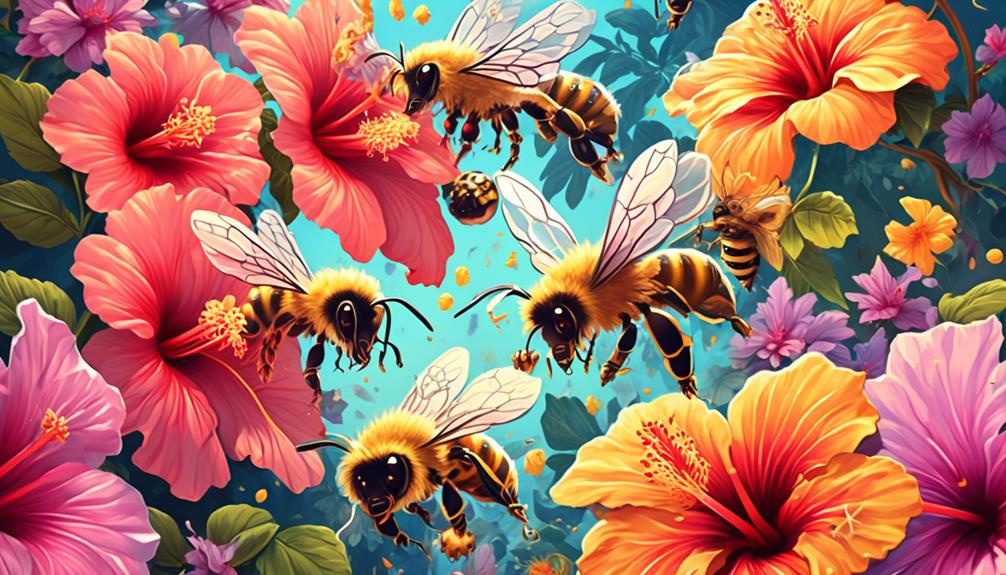
Often, you may observe bees buzzing around brightly colored flowers, specifically drawn to their vibrant hues and sweet nectar, a fascinating instance of nature's symbiosis that underscores the significant role bees play in pollination. This isn't by chance, but a meticulously evolved trait.
Bees see the world differently than humans. They can't see the color red but perceive ultraviolet light, invisible to our eyes. Many flowers, including hibiscus, exhibit UV patterns, often termed as 'nectar guides,' that are particularly attractive to bees.
The sweet nectar serves as a lure too, providing bees with essential energy. But it's not just the sweetness; the scent of the nectar also plays a crucial role. Each flower has a unique fragrance that acts as a chemical signal, enabling bees to distinguish between different plant species.
Moreover, a flower's shape and structure contribute to this attraction. For instance, hibiscus flowers have a tubular structure, facilitating bees' nectar access while ensuring pollen sticks onto them for the next pollination cycle.
Understanding this complex interaction can help you appreciate bees' vital role, their floral preferences, and their critical contribution to our ecosystems.
The Alluring Hibiscus Plant
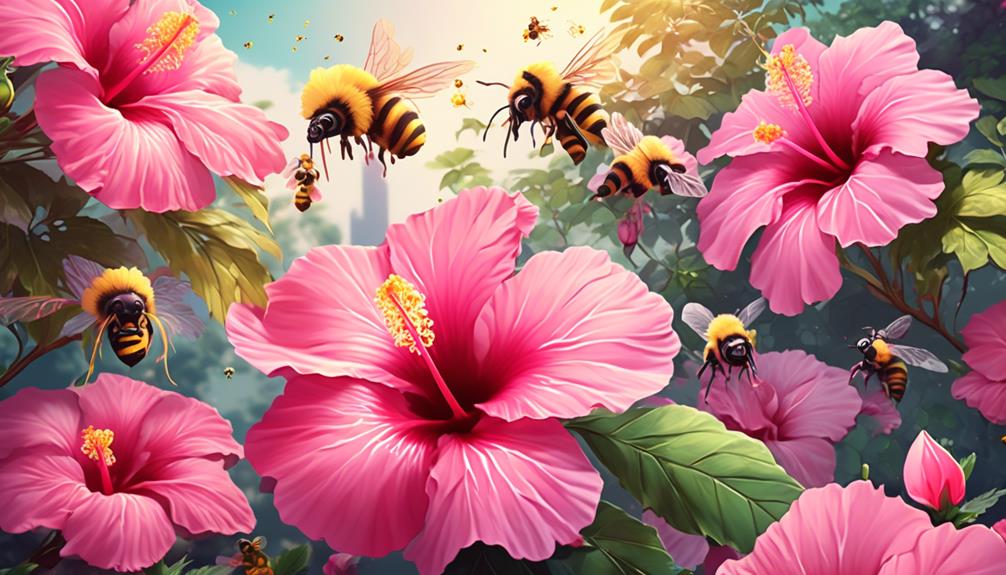
Diving into the world of hibiscus plants, you'll find them to be a vital part of bees' lives due to their vibrant colors, uniquely structured blossoms, and enticing nectar.
In the scientific lexicon, these plants belong to the genus Hibiscus, exhibiting an incredible diversity with over 200 species. They're known for their large, trumpet-shaped flowers that come in a range of colors, making them visually appealing not just to humans, but to bees as well.
The anatomy of the hibiscus flower is particularly fascinating. The colorful, funnel-shaped structure is designed to attract pollinators. Its protruding stamen, laden with pollen, is strategically positioned to ensure contact with bees. When a bee lands on a blossom to collect its nectar, it inadvertently brushes against the pollen-laden stamen, leading to pollination.
The nectar of hibiscus plants acts as a powerful attractant for bees. It's rich in vital nutrients, offering a substantial reward for their pollination services. Therefore, the hibiscus plant isn't merely a feast for the eyes, but a critical component of the bee's survival and propagation.
Bees and Hibiscus: Observations
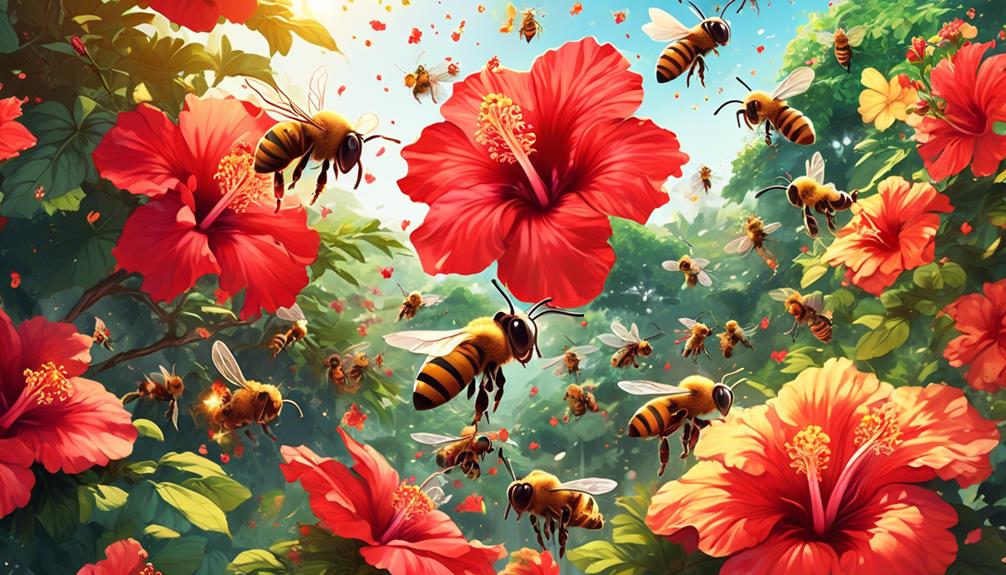
Having understood the role of hibiscus plants in a bee's life, let's now observe the intricate interaction between these buzzing pollinators and the vibrant hibiscus blossoms.
You'll notice that bees are particularly attracted to the hibiscus due to its bright colors and nectar-rich flowers. The bees' keen vision allows them to spot the colorful hibiscus from a distance, and their heightened sense of smell leads them directly to the nectar source.
As you watch bees hover over the hibiscus, it's fascinating to see how efficiently they move from bloom to bloom, collecting nectar. They're not just feeding themselves, but also transferring pollen from the stamens of one hibiscus flower to the pistil of another, aiding in plant reproduction. This simple act of cross-pollination is crucial for the survival of both the hibiscus and the bees.
Observe the bees' hind legs. You'll see clumps of yellow pollen gathered there. It's nature's way of ensuring that as the bees go about their food-seeking, they're also playing a significant role in the pollination process.
This symbiotic relationship between bees and hibiscus is a testament to nature's interconnectedness.
Factors Affecting Bees' Preferences
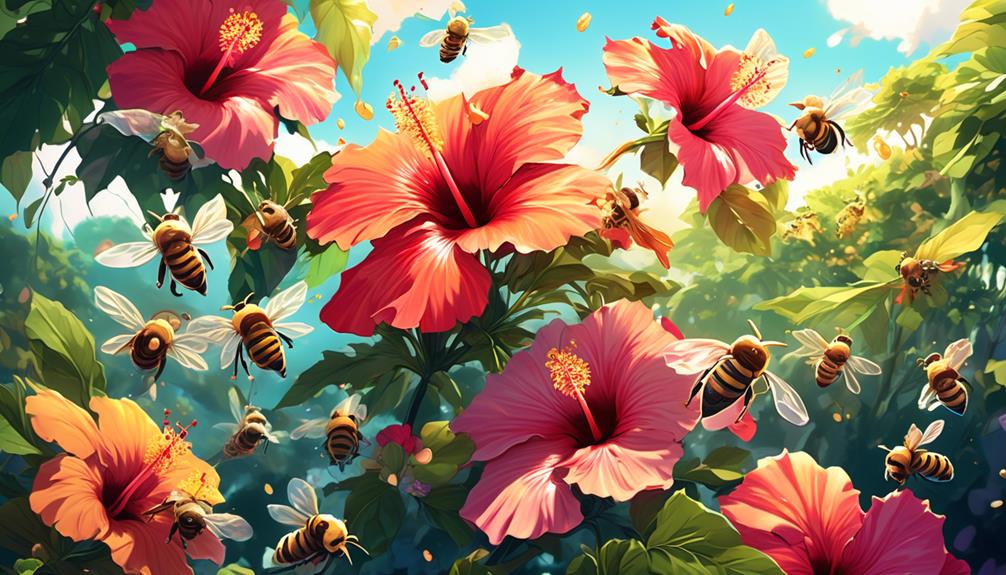
To fully grasp why bees favor certain flowers, like the hibiscus, it's essential to examine various factors that influence their preferences. You should consider the intricate interplay between bee biology, flower characteristics, and environmental conditions.
Bees are attracted to flowers that provide abundant nectar and pollen, their primary food sources. Specific flower attributes, such as color, scent, and shape, can significantly influence bees' preferences. For instance, bees tend to favor bright colors, especially blue and yellow, and floral scents that signal a rich nectar source. The shape of a flower can also determine its attractiveness to bees; the hibiscus, with its large, flat petals, makes it easy for bees to land and collect nectar.
Environmental conditions also play a role. Bees are more active in warm, sunny conditions and less so in cold, windy or rainy weather. Additionally, bees' preferences can be affected by the proximity of flowers to their hive, competition from other pollinators, and the availability of other food sources.
Leveraging Bees' Love for Hibiscus

Understanding the bees' affinity for hibiscus can significantly enhance your beekeeping strategies, particularly in boosting nectar production and optimizing pollination efficiency. Analyzing the bees' preference for hibiscus, you'll find they're attracted to the plant's nectar-rich blooms, which are usually large, vibrant, and abundant in pollen.
The strategic placement of hibiscus plants in your apiary can attract more bees, leading to increased nectar collection and greater honey production. You'll create an environment that's not just conducive to bee activity, but one that actively encourages it.
In terms of pollination, hibiscus plants are excellent choices for promoting bee activity due to their bright colors and large flower sizes. This can lead to more effective and efficient pollination within your garden or farm.
Remember, it's not only about attracting bees but also about keeping them. Providing a consistent source of high-quality nectar, like that found in hibiscus, will keep your bees returning and working hard.
Lastly, consider the timing. Hibiscus plants typically bloom in late spring to early fall, providing bees a rich nectar source when many other plants aren't in bloom. Strategically incorporating hibiscus into your beekeeping approach can help ensure a steady, productive hive.
Frequently Asked Questions
What Other Flowers, Besides Hibiscus, Are Bees Commonly Attracted To?
You're curious about the types of flowers bees are attracted to, besides hibiscus. They're particularly drawn to brightly colored, fragrant blooms like lavender, daisies, and sunflowers.
Bees also love herbs like rosemary and thyme. They're very fond of native wildflowers too.
How Can I Safely Encourage Bees to Visit My Garden Without Getting Stung?
You can safely attract bees to your garden without getting stung by providing a variety of native plants, ensuring a constant supply of blooming flowers.
Bees prefer blue, purple, and yellow flowers.
Keep a clean water source for them.
Don't swat at bees; move slowly and calmly around them.
Avoid wearing strong scents.
What Are the Environmental Benefits of Bees Being Attracted to Hibiscus Plants?
You're asking about the environmental benefits of bees being attracted to hibiscus plants.
Well, bees pollinate these plants, promoting biodiversity. This process not only helps hibiscus plants reproduce, but it also supports the growth of other plants in the ecosystem.
Additionally, attracting bees helps maintain their population, which is vital as they're a keystone species. Without them, our food supply would be seriously threatened.
Are There Specific Species of Bees That Are More Attracted to Hibiscus Than Others?
Yes, certain species of bees show a higher affinity towards hibiscus plants.
Honey bees, bumble bees, and carpenter bees are particularly drawn to the hibiscus' large, colorful blooms. These bees are attracted to the plant's nectar and pollen, which they use for food and reproduction.
However, the specific attraction can vary based on the bee species' individual preference and the type of hibiscus plant.
It's a fascinating study in nature's diversity and specificity.
Can the Attraction of Bees to Hibiscus Have Any Negative Effects on the Plant or Surrounding Vegetation?
In general, bees' attraction to plants like hibiscus isn't harmful. Bees help with pollination, which is vital for plant reproduction.
However, if bees are overpopulated, they might potentially exhaust the nectar and pollen resources, which could affect the plant's health. But, it's rare.
Also, there's no direct negative effect on the surrounding vegetation, unless the bees are carriers of diseases that can affect plant health.
Conclusion
So, you've discovered bees do indeed have a fondness for hibiscus. Various factors, such as color and nectar availability, draw them in. While not every bee may prefer hibiscus, enough do to leverage for pollination purposes.
Understanding these preferences aids in planning your garden or studying bee behavior. Remember, the more we comprehend about these intricate relationships, the better we can support both bees and plants like the hibiscus in their crucial environmental roles.

